Ford Explorer
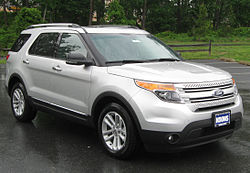 | |
| Manufacturer | Ford Motor Company |
|---|---|
| Production | 1990–present |
| Model years | 1991–present |
| Predecessor | Ford Bronco II |
| Class | Mid-size SUV (1991–2010) Full-size crossover SUV (2011–) |
The Ford Explorer is a sport-utility vehicle sold in North America and built by the Ford Motor Company since 1990, as a replacement for the smaller but related Ford Bronco II. It is manufactured in Chicago, Illinois (it was also assembled in Hazelwood, Missouri until the plant closed on March 10, 2006). The Ford Explorer was instrumental in turning the SUV from a special-interest vehicle into one of the most popular vehicle types on the road. Model years through 2010 were traditional mid-sized SUVs, with the redesign for the 2011 model year classifying it as a full-sized crossover SUV. It is slotted between the larger Ford Expedition and the smaller Ford Escape. Although outwardly similar, the Explorer and Ford Edge do not share platforms.
The Explorer has also been involved in controversy, after a spate of fatal rollover accidents involving Explorers fitted with Firestone tires. Both two-door Explorer Sportand four-door models of Explorer have been sold. Part-time four-wheel drive is an available option, and since 1995 this has been a 'shift on the fly' system with full protection against being engaged at high speed. A specially modified Special Service Vehicle version is also available from Ford Fleet for law enforcement agencies, fire departments, and EMS agencies. Explorer was also the name of a trim package offered on the Ford F-Series trucks from 1968 to 1986. The 2011 Ford Explorer was named North American Truck of the Year.
First generation (1991–1994)
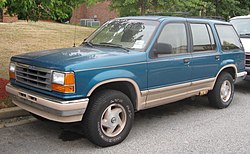 | |
| Production | 1991–1994 |
|---|---|
| Assembly | Louisville, Kentucky, United States St. Louis, Missouri, United States Valencia, Venezuela |
| Body style | 3-door SUV 5-door SUV |
| Layout | Front engine, rear-wheel drive / four-wheel drive |
| Engine | 4.0 L Cologne V6 |
| Transmission | 5-speed M5OD-R1 manual 4-speed A4LD automatic |
| Wheelbase | 3-Door: 102.1 in (2593 mm) 5-Door: 111.9 in (2842 mm) |
| Length | 3-Door: 174.5 in (4419 mm) 5-Door: 184.3 in (4673 mm) |
| Width | 70.2 in (1778 mm) |
| Height | 3-Door: 67.5 in (1714 mm) 5-Door: 67.3 in (1709 mm) Eddie Bauer 4-Door 4WD: 68.3 in (1735 mm) |
| Related | Mazda Navajo Ford Ranger Mazda B-Series |
The Explorer was released in March 1990 as a 1991 model. It was equipped with a 4.0-liter 16-valve OHV 155 hp (116 kW) V6 engine and either the 4-speed A4LD automatic transmission or 5-speed M5OD manual transmission. Like the Bronco II it replaced, it was an SUV derivative of the Ranger pickup, and came equipped with many of the Ranger's optional features. Like its direct competitor, the Chevrolet S-10 Blazer, it was available in both 2-door and 4-door body styles, and with rear or four-wheel drive. The four-wheel-drive versions were equipped with a Borg Warner 13–54 part-time four-wheel-drive transfer case. The 13–54 was available with "Touch Drive" electronic push-button shifting or manual lever-operated shifting. Both were "shift-on-the-fly" designs that allowed the Explorer to be shifted from two-wheel drive to "four-high" at any speed, although "four-low" was only available when the vehicle was stopped. All Explorers were equipped with the Ford 8.8 axle in either a limited slip or open version with a variety of available gear ratios. Four-wheel-drive front axles were the TTB ("Twin Traction Beam") Dana 35 with some Dana 44-spec components.
Explorers initially came in 4 trim levels: base XL, XLT, Sport (only available on the two-door version), and the upscale Eddie Bauer edition. For the 1993 model year, engine output was increased by 5 hp (4 kW) for a total of 160 hp (119 kW). The Limited edition, added for 1993, was available only in the 4-door body style and was positioned at the top of the lineup above the Eddie Bauer edition. It featured automatic headlights, an auto-dimming rear-view mirror, foglamps, a center roof console with compass and outside thermometer, unique wheels and grille, and an automatic transmission as standard equipment. Both the grill and headlight trims on the Limited model were paint-matched to the body color, unlike the chrome or black versions on other trim levels.
Technically similar to the 4-door Ford Explorer, the 2-door Explorer came in both rear-wheel drive and four-wheel drive variants. It replaced the 2-door Ford Bronco II, and was larger than the Bronco II. A variant of the 2-door Explorer Sport was sold by Mazda as the Navajo, which won Motor Trend's Truck of the Year award but was discontinued in 1994. Many, but not all 2-door Explorers are badged as Sport models.
Common complaints about the first generation models mostly came from the A4LD automatic transmission, which was not well-suited for towing and was unable to cope with higher power output from modified engines; improved fluid cooling using aftermarket transmission coolers can alleviate these issues. The automatic locking front hubs also tended to fail prematurely; the manual versions, made for Ford by Warn, suffered from fewer reliability problems.
Second generation (1995–2001)
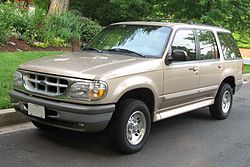 | |
| Production | 1995–2001 1995–2003 for Sport |
|---|---|
| Assembly | Louisville, Kentucky, United States St. Louis, Missouri, United States Valencia, Venezuela |
| Body style | 3-door SUV(1995–2001) 5-door SUV(1995–2001) |
| Layout | Front engine, rear-wheel drive / four-wheel drive |
| Engine | 4.0 L Cologne V6 4.0 L Cologne SOHC V6 5.0 L Windsor V8 |
| Transmission | 5-speed M5OD-R1 manual 4-speed 4R55E automatic 4-speed 4R70W automatic 5-speed 5R55E automatic |
| Wheelbase | 1995–97 5-door: 111.5 in (2831 mm) 1998–2001 5-door: 111.6 in (2834 mm) 1995–99 3-door: 101.7 in (2565 mm) 2000–03 3-door: 101.8 in (2568 mm) |
| Length | 1998–2001 5-door: 190.7 in (4826 mm) 1998–99 3-door: 180.8 in (4572 mm) 1995–97 5-door: 188.5 in (4788 mm) 1995–97 3-door: 178.6 in (4536 mm) 2000–03 3-door: 180.4 in (4562 mm) |
| Width | 70.2 in (1778 mm) |
| Height | 67.0–68.3 in (1702–1735 mm) |
| Related | Mercury Mountaineer Ford Ranger Mazda B-Series |
The Explorer saw significant exterior, interior and suspension updates in 1995. The 4.0L Cologne OHV V6 from the previous generation Explorer carries over. The former "Twin Traction Beam" (TTB) front suspension was replaced with a more carlike independent front suspension. The Explorer lineup now consisted of two models: 2-door Explorer Sport and the 4-door Explorer. The Limited was a higher end 4-door. Selectable part-time/full-time ControlTrac 4-wheel-drive débuted with a two-speed transfer case featuring three-modes, 2wd, 4 High and 4 Low. The 1995 Explorer was the first production vehicle to use a neon center high mount stop lamp. It also was the first vehicle in its segment to have dual front airbags.
The 5.0L V8 powered Explorer has become favored in the high performance SUV crowd, with many performance parts available. This is due to the fact that many aftermarket 5.0 L Ford Mustang parts are interchangeable with the Explorer variant.
There are aftermarket parts available for 95-01 Explorers including superchargers, nitrous kits, and headers.
Significant year to year changes
1996
- 5.0-liter Windsor V8 engine and heavy-duty 4-speed 4R70W transmission added
- "Full time" all-wheel-drive system becomes available only for V8 powered models
1997
- An updated, more powerful version of the current pushrod V6 added to option list for all models ; the 4.0L Cologne SOHC V6
- A new 5 speed automatic transmission, the 5R55E, is now the only available automatic transmission for all V6 powered Explorers. It's the first 5 speed automatic transmission in any North American automobile.
- The option of having rear wheel drive on a 4x4 Explorer is no longer. "2wd" is removed from the transfer case selection knob on 4x4 models. It is replaced with "Auto". When the Control Trac 4x4 system senses rear wheels slipping, it transfers power to the front wheels.
- The Explorer's twin, the Mercury Mountaineer debuts
- In early 1997, the 5.0 L V8 received new cylinder heads (GT-40P series), which upped power to 215 hp (160 kW)
1998
- Stereos are redesigned
- Lift-gate redesigned
- Rear bumper redesigned
- Tail lights redesigned
- The neon center high mount stop lamp is no longer and is replaced with a more conventional LED lamp.
1999
- Seats redesigned
- Fog lights redesigned
- Front bumper redesigned
- XL model (base model) is renamed "XLS"
Like the basic Explorer, the Explorer Sport was significantly updated in 1995. The Eddie Bauer trim level was replaced with Expeditionon 2-door Explorers (1995 only, the name would be reused on the 1997 Ford Expedition).
There was a North Face model also introduced, but was exclusive to the UK.
2001 also saw the introduction of the Explorer Sport Trac, which put a small pickup bed behind the four normal SUV doors.
In 2009, this generation Explorer had five of the top seven spots for vehicles traded in under the "cash for clunkers" program, with the 1998 model topping the list. The 1994 model from the previous generation also had the eighth spot on the list.
Engine specifications
| Ford 4.0L Cologne OHV V6 | |
|---|---|
| Model years | 1995–2001 |
| Power (SAE net) | 160 hp (119 kW) |
| Torque (SAE net) | 220 ft·lbf (300 N·m) |
| Ford 4.0L Cologne SOHC V6 | |
|---|---|
| Model years | 1997–2001 |
| Power (SAE net) | 205 hp (153 kW) |
| Torque (SAE net) | 245 ft·lbf (332 N·m) |
| Ford 5.0L Windsor OHV V8 | |
|---|---|
| Model years | 1996–2001 |
| Power (SAE net) | 210 hp (157 kW) |
| Torque (SAE net) | 280 ft·lbf (380 N·m) |
Third generation (2002–2005)
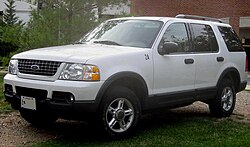 | |
| Production | 2002–2005 (up to 2006 in the Philippines) |
|---|---|
| Assembly | Louisville, Kentucky, US St. Louis, Missouri, US Valencia, Venezuela |
| Body style | 5-door SUV |
| Layout | Front engine, rear-wheel drive / four-wheel drive |
| Engine | 4.0 L Cologne V6 4.6 L 16-valve Modular V8 |
| Transmission | 5-speed M5OD-R1HD manual 5-speed 5R55W automatic 5-speed 5R55S automatic |
| Wheelbase | 2002–03: 113.7 in (2888 mm) 2004–05: 113.8 in (2890 mm) |
| Length | 189.5 in (4800 mm) |
| Width | 72.1 in (1828 mm) |
| Height | 71.4 in (1803 mm) |
| Related | Lincoln Aviator Mercury Mountaineer Ford Explorer Sport Trac |
The 4-door Explorer and companion Mercury Mountaineer were redesigned entirely in 2002, losing all design similarity with the Ranger while gaining a similar appearance to the Ford Expedition (the third generation Explorer is frequently confused with the second generation Expedition, having rounded wheel sockets and "larger" back lights along with a more rounded appearance overall) and the still in production, second generation inspired Explorer Sport Trac. Engines were either the 210 hp (157 kW) SOHC 4.0L V6 with 254 ft·lbf (344 N·m) of torque or a 4.6-liter SOHC V8 producing 239 hp (178 kW) and 282 ft·lbf (382 N·m) of torque. The 4.0-liter 16-valve SOHC V6 producing 203 hp (151 kW) 240 ft·lbf (330 N·m) of torque still available on the Explorer Sport. A third-row seat became available for the first time, bringing total passenger capacity to seven. Both manual and automatic transmissions and all-wheel drive were available (with 2002 being the last year of being able to order a 4-door and manual transmission). Trim lines were the base Sport Value, Sport Choice, XLS,Sport Premium, XLT, Eddie Bauer, and top Limited. AdvanceTrac with Roll Stability Control were standard for 2005 but an option from 2002 and on.
Beginning with the 2002 model year, Ford installed a fully independent rear suspension in the Explorer and Mercury Mountaineer (but not in the 2-door Explorer Sport). This replaced the non-independent ("live-axle") rear suspension used in previous model year Explorers. In the fully independent rear suspension each rear wheel connects to the rear differential via a half-shaft drive axle. The benefits of a fully independent rear suspension for ride comfort, handling, and vehicle stability have been known for many years, and many rear- or 4-wheel-drive vehicles (cars and SUVs) use this type of suspension; for example, the Hummer H1, and the Mercedes-Benz ML SUV. Ford installed the independent rear suspension in the Explorer beginning with the 2002 model year because of the well-publicized vehicle rollovers and resulting fatalities that occurred with previous-edition Ford Explorers. All of the Explorers involved in the rollovers had non-independent rear suspensions, and many of the vehicles had tires which Ford judged to be defective see below
All three SUVs use code U6 (for rear-wheel drive), U7 (for four-wheel drive), and U8(for all-wheel drive) in the 5th, 6th, and 7th positions of the VIN.
When the Explorer was redesigned for 2002, the Explorer Sport continued unchanged for 1 more year. Due to the decline of 2-door SUVs, the 2-door Explorer Sport was discontinued in 2003.
Fourth generation (2006–2010)
 | |
| Production | 2006 – December 2, 2010 |
|---|---|
| Assembly | Louisville, Kentucky, US St. Louis, Missouri, US Valencia, Venezuela |
| Body style | 5-door SUV |
| Layout | Front engine, rear-wheel drive / four-wheel drive |
| Engine | 4.0 L Cologne V6 4.6 L 24-valve Modular V8 |
| Transmission | 5-speed 5R55S automatic 6-speed 6R automatic |
| Wheelbase | 113.7 in (2890 mm) |
| Length | 193.4 in (4902 mm) |
| Width | 73.7 in (1854 mm) |
| Height | 2006–07: 71.2 in (1803 mm) 2008: 72.8 in (1,849 mm) 2009–10: 71.9 in (1,826 mm) |
| Related | Mercury Mountaineer Ford Explorer Sport Trac |
The Explorer and the Mountaineer were updated for 2006 on a new frame, produced by Magna International rather than Tower Automotive. It was upsized, because the Ford Freestyle (later called Ford Taurus X), slotted between it and the Escape. Along with this new, stronger base were a new interior, redesigned rear suspension, and power-folding third-row seats. A tire-pressure monitoring system and Electronic stability control were standard. Power running boards (like those on the Lincoln Navigator) that lower to allow easier to access for someone entering the vehicle and then later retract upon door closure were available. Unlike previous Explorers, there was no right-hand drive version. The new Explorer was marketed in Japan in a left-hand drive configuration, as LHD vehicles are considered prestigious there.
Ford reverted to a one piece rear door due to reports of cracks that appeared on the plastic panel below the rear window. Third-generation Explorers and Mercury Mountaineers can sometimes be seen with a single crack vertically, close to the center Ford oval badge.
A 210 hp (157 kW) 4.0-liter 16-valve SOHC V6 was the base engine, with the 292 hp (218 kW) 24-valve SOHC V8, similar to the Mustang engine, as the top choice. A six-speed automatic transmission was available with this engine as well.
The Explorer was nominated for the North American Truck of the Year award for 2006.
A new Sport Trac was added to the Explorer line in early 2006 for the 2007 model year. Unlike its predecessor sold through 2005, it featured the V8 engine as an option, and was based on the new, larger Explorer platform. AdvanceTrac with Roll Stability Control was standard in the Sport Trac.
A special 2007 SVT model called the Sport Trac Adrenalin was to use a supercharged version of the 4.6 L Modular V8, with 390 hp (291 kW) and featuring 21-inch (530 mm) wheels. It was to be a successor to the F-Series Lightning pickup. However, it was cancelled in a cost-cutting move, as part of The Way Forward.
In 2008, Ford added side curtain airbags across the range. The satellite navigation system was upgraded with voice control. In 2009, the Explorer got trailer sway control standard and the navigation system got traffic flow monitoring with updated gas prices from nearby stations. For the 2010 model year, Ford's MyKey became standard on all Explorer trims.
Explorer America concept
Ford unveiled an Explorer America concept vehicle at the 2008 North American International Auto Show. The Explorer America concept is built on a unibody platform to reduce weight and improve driveability, migrating from the body-on-frame platform of the fourth generation Explorer. It is designed for up to six passengers while improving fuel economy by 20 to 30 percent relative to the current V6 Explorer. The powertrain packages in the concept vehicle include a two-liter four-cylinder turbocharged direct injection EcoBoost gas engine with 275 hp (205 kW) and 280 ft·lbf (380 N·m) of torque, and a 3.5 L V6 version EcoBoost with 340 hp (254 kW) and up to 340 ft·lbf (460 N·m) of torque.
Fifth generation (2011–)
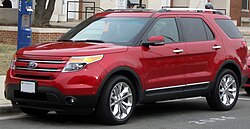 | |
| Production | December 3, 2010–present |
|---|---|
| Assembly | Chicago, Illinois, United States Valencia, Venezuela Tatarstan, Russia |
| Body style | 5-door SUV |
| Layout | Front engine, front-wheel drive /four-wheel drive |
| Platform | Ford D4 platform |
| Engine | 2.0 EcoBoost I4 3.5 Duratec V6 3.5 EcoBoost V6 |
| Transmission | 6-speed automatic |
| Wheelbase | 112.6 in (2,860 mm) |
| Length | 197.1 in (5,010 mm) |
| Width | 78.9 in (2,000 mm) |
| Height | 70.4 in (1,790 mm) |
| Related | Ford Taurus Ford Flex Lincoln MKS Lincoln MKT |
The fifth generation 2011 Explorer takes cues from the Explorer America concept's construction, and includes a monocoque (unibody) structure based on the D4 platform, a modified version of the D3 platform. The new Explorer features blacked-out A, B, and D-pillars to produce a floating roof effect similar to Land Rover’s floating roof design used on its sport utility vehicles. Ford already uses this floating roof design on the Ford Flex. The Explorer's C-pillar remains body colored. It also gets sculpted body work with stepped style headlamps similar to the Flex, Edge,Escape, Expedition and F-150. In addition, the Explorer receives new stepped style tail lamps. The grille will receive the corporate three-bar design with upper and lower perforated mesh work, similar to that of the sixth-generation Taurus.
The Explorer's chief design engineer is Jim Holland, who was also a chief design engineer for Land Rover. Holland is responsible for the design of the current generation Land Rover Range Rover (L322). Holland also worked on the outgoing Ford Expedition (U324) during its initial development.
The fifth generation 2011 Explorer, developed under the U502 program code name, made its debut online on July 26, 2010. Ford had set up a Ford Explorer Facebook page ahead of its debut. Assembly of the fifth-generation Explorer moved to Ford's Chicago Assembly plant, where it is built alongside the Ford Taurus and Lincoln MKS. The Louisville plant, where the previous generation was built, was converted to produce cars based on Ford's global C platform (potentially including the Ford Focus, Ford C-Max, and Ford Kuga). Like the Escape, the Explorer will continue to be marketed as an "SUV" rather than a "crossover SUV". It went on sale in early 2011; pre-launch sales had by the end of November 2010 totaled around 15,000.
Features
Available features include intelligent access with push button start, remote engine start, power liftgate, power adjustable pedals with memory, premium leather trimmed seating, heated and cooled front seats, dual headrest DVD entertainment system, adaptive cruise control, active park assist, SIRIUS Travel Link, MyFord Touch,Ford SYNC by Microsoft, Sony audio system with HD radio and Apple iTunes tagging, in-dash advanced navigation system, SoundScreen laminated acoustic and solar tinted windshield with rain-sensing wipers, 20-inch polished V-spoke aluminium wheels, high intensity discharge (HID) headlamps and LED tail lamps.
Capability
The Explorer is available in either front-wheel-drive or full-time four-wheel-drive. Only one engine was initially available: a standard 3.5L TiVCT twin independent variable camshaft timing V6 (290 hp (216 kW), 255 lb·ft (346 N·m) of torque) mated to a 6-speed 6F automatic with a 6-speed 6F SelectShift automatic as an option.
A second optional engine has less horsepower, but gets better mpg: a 2.0L EcoBoost turbocharged, direct injected I-4 (237 hp (177 kW), 250 lb·ft (340 N·m) of torque) mated to a 6-speed 6F automatic. The I-4 engine will not be available with the optional 6-speed 6F SelectShift automatic and will only be available in front-wheel-drive form.
The Explorer is available with full-time Intelligent four-wheel drive using open front & rear differentials with 3.39:1 gearing and an electronic center coupling by Haldex. The electronic center coupling controls the front-to-rear torque distribution (torque split) between the front & rear drive wheels and acts as a center differential to allow for full-time operation. The power take off (PTO) unit has a heavy-duty dedicated cooling system to allow the front drive based, four-wheel-drive system to supply continuous non-stop torque delivery to all four wheels indefinitely without overheating. "4WD" badging is also included on the rear liftgate. Explorer’s overall off road crawl ratio is 15.19:1 with high range gearing only.
Off road electronics include Hill Descent Control (HDC), Hill Ascent Assist (HAA), 4-wheel electronic traction control and Terrain Management.
4-wheel electronic traction control (ABS braking) is employed to force the open front and rear differentials to behave like limited-slip differentials, transferring torque from side-to-side. In the right conditions, the Explorer can keep moving even if only one front wheel has traction.
Terrain Management will include four selectable modes. Each mode can be selected via a rotary control dial on the center console, aft of the transmission shifter.
| Terrain Management System | |
|---|---|
| Default start selection: | Normal Driving mode |
| Subsequent modes are selected by turning the control dial clockwise. | |
| Second selection: | Mud & Ruts mode |
| Third selection: | Sand mode |
| Fourth selection: | Grass/Gravel/Snow mode |
Depending on the mode selected, Terrain Management will control, adjust and fine tune the engine, transmission, electronic center coupling, throttle response, 4-wheel electronic traction control and electronic stability control (ESC) to adapt the SUV for optimal performance on the corresponding terrain.
Off road geometry figures for approach, departure and ramp brakeover angles are 21°, 21° and 16° respectively.Minimum running ground clearance is 7.6 inches (193 mm).Standard running ground clearance is 8.2 inches (208 mm). Low hanging running boards are no longer offered from the factory to help increase side obstacle clearance.
Unlike the Explorer America concept vehicle which only seats five occupants, the production Explorer will have two rows of seating with available PowerFold fold flat third row seating (like the previous generation) and will be able to accommodate up to seven occupants.
Moving to a monocoque body usually has a negative impact on towing capacity. The new Explorer will be available with an optional trailer tow package. The package includes a Class III trailer hitch, engine oil cooler, trailer electrics connector, trailer sway control (TSC), wiring harness and a rear-view camera with trailer alignment assistance to help in backing up to a trailer. If equipped with the trailer tow package the new 2011 Explorer will be able to tow up to 5,000 lb (2,300 kg) of braked trailer. That’s 1,500 lb (680 kg) greater than the towing capacity stated for the Explorer America concept and 2,115 lb (959 kg) less than the outgoing Explorer’s towing capacity, although that was only available with the 4.6 L V8 engine.
Safety and security
Safety features include: Dual front adaptive SRS air bags, dual front seat side impact air bags, dual rear safety belt air bags (available first quarter, 2011) and side curtain head, torso and rollover protection air bags. Other safety features include BLIS blind spot information system with cross traffic alert, collision warning with brake support precrash system, Roll Stability Control (RSC), Electronic stability control (ESC) and Curve Control.
The fifth-generation Explorer will be the first-ever vehicle to be equipped with inflatable dual rear safety belt air bags. Air bags are sewn into the inside of the seat belts, and inflate with cold air to prevent burns. Ford claims it will be released as an option and to introduce inflatable seat belts on other Ford models eventually.
Awards
The current generation Ford Explorer earned the 2011 North American Truck of the Year award. The rear inflatable seat belts won the 2011 Best New Technology Award from the Automobile Journalists Association of Canada.
2013 Ford Explorer Sport
The Ford Explorer Sport was announced March 28, 2012 as an option for the 2013 model year and went on sale in June 2012. The "Sport" trim level comprises blackened exterior treatments, stiffened chassis and suspension, larger brakes and the installation of the EcoBoost 3.5L Twin Turbo V6 rated at 350 hp, and is the only version to feature a combined 4WD/EcoBoost option (a FWD version is not being offered for the Sport trim), allowing its MPG to average between 16/city and 23/highway.This version will be slotted above the Limited trim and is expected to compete in this segment against Jeep Grand Cherokee's SRT Sport and Dodge Durango's R/T trims and a newly updated 2013 Chevrolet Traverse, the latter of which unveiled their new look on the same day as the Explorer Sport as their response to Ford's news.
Explorer Sport variation
The Ford Explorer Sport was a 2-door version of the Ford Explorer, designed to take the place of the Bronco II in Ford's model line, and was produced from 1991 to 2003. The Sport began as a trim level of the Ford Explorer, but it eventually became its own model. It rode on a 10" shorter wheelbase. There was only one Sport, but there were several other trim levels of the Explorer that were available with 2-doors (edmunds trim levels), such as the XL (1991–1997), the Eddie Bauer (1991–1994), and the Expedition (1995). In 1998 the Explorer Sport became the only 2-door trim level of the Explorer, and in 2001 it became its own model, as the second generation Explorer moved on to a 4-door-only 3rd generation. As mentioned above, the Explorer Sport will return as an upgraded 4-door trim for the 2013 model year.
Special Service Vehicle
To compete with other police SUVs that are sold by other automobile companies, Ford has made a special version of the Explorer that's only available to law enforcement agencies, fire departments, and EMS agencies. Ford calls it the Explorer Special Service Vehicle (SSV). The only differences between the standard Explorer and the Special Service Vehicle Explorer are provisions for emergency services related equipment such as radios, lightbars and sirens. There are also options designated fleet only such as custom 2 tone paint arrangements that are available to the Explorer Special Service Vehicle.
The 2013 Explorer will have a Police Interceptor variant for police use.
Export sales
UK models
In the UK, the Ford Explorer was initially available as just one model, with the 4.0-litre engine and with a high specification – the only dealer options being leather interior. In 1998, a facelifted Explorer was available with minor cosmetic interior changes and a revised rear tail lift which centered the rear number plate. In 1999 the model range was revamped slightly, the base model becoming the XLT and a special edition North Face version marketed with a tie in to North Face outdoor clothing. The North Face version was available in a dark green or a silver, with body-colored bumpers, heated leather seats and a CD multichanger as standard. In 2000, the North Face was also available in black. With the introduction of the all-new platform in 2002, Ford withdrew the Explorer from the UK market.
Current exports
As of 2009, the Explorer Made in North America is exported to Bolivia, Canada, Mexico, Dominican Republic, Japan, South Korea, Israel, The Philippines, Russia, Iceland, the Middle East, and certain countries in South America and Africa.
Controversies
Rollover and Firestone Tire controversy
Rollover risk is inherently higher than cars in many truck-based vehicles if they are driven unsafely, as modification for bulky 4-wheel-drive hardware requires increases in height to avoid compromising ground clearance (raising the center of gravity), while a short wheelbase further reduces stability. The previous Bronco II had already been cited by Consumer Reports for rollover tendencies in turns; as with the Explorer, however, it was cleared by the NHTSA as being no more dangerous than any other truck when driven unsafely. With a longer passenger compartment, the Explorer added 600 pounds, but Ford did not deem it necessary to revise the suspension or tires to carry the bigger load. It used the same tires as the Ford Ranger with a relatively low rating for high temperatures. Lowering tire pressure recommendations softened the ride further and improved emergency stability through increased traction, but increased the chances of overheating tires. A 1995 redesign with a new suspension slightly raised the Explorer's center of gravity, but it was called inconsequential by a Ford spokesman. Memos by Ford engineers suggested lowering the engine height, but it would have increased the cost of the new design.
In May 2000, the US National Highway Traffic Safety Administration (NHTSA) contacted Ford and Firestone about a higher than normal incidence of tire failures on Ford Explorers, Mercury Mountaineers, and Mazda Navajos fitted with Firestone tires (later including Ford Ranger and Mazda B-Series pickup trucks). The failures all involved tread separation, in which the outer tread carcass would delaminate and cause a rapid loss of tire pressure. Ford investigated and found that several models of 15 in (381 mm) Firestone tires (ATX, ATX II, and Wilderness AT) had higher failure rates, especially those made at Firestone's Decatur, Illinois plant.
Ford' recommended a tire inflation of only 26 pounds per square inch (179 kPa) likely contributing to the tread separation problem by causing the tires to operate at higher than normal temperatures. However, Ford argued that Firestone was at fault, noting that its SUVs and pickups equipped with Goodyear tires experienced no rollover issues, even when inflated at low air pressure.
Part of the rollover issue was poor driver reaction to the tire blowout. When a tire blew, the vehicle would experience a sudden sharp jerk, and many drivers reacted by counter-steering in an attempt to regain control. This action would cause a shift of the vehicle's weight, resulting in a rollover especially at higher speeds (many reports of rollovers were of vehicles being driven at speeds of 70 mph (110 km/h) and above). In a test simulating dozens of tire blowouts, Larry Webster, a test-driver for Car & Driver magazine, was repeatedly able to bring a 1994 Explorer to a stop without a single rollover, even at speeds of 70 mph (110 km/h).According toForbes magazine, car experts and NHTSA claim that the vast majority of crash accidents and deaths are caused not by the vehicle, but by the driver, by road conditions or some combination of the two.
In response to Firestone's allegations of the Explorer's design defects, NHTSA undertook a preliminary investigation and reported that further action was not required. Its conclusion was that the Explorer was no more prone to rollover than other SUVs given their highcenter of gravity.The subsequent introduction and proliferation of electronic stability control systems have essentially addressed and mitigated this shortcoming.
U-Haul trailers
On December 22, 2003, U-Haul, the largest North American equipment rental company, announced that they would prohibit their outlets from renting trailers to persons planning to tow behind Ford Explorers due to liability concerns, with no published data to substantiate their claim.U-Haul did not alter their policies regarding the renting of trailers to persons planning to tow behind the Mercury Mountaineer, Mazda Navajo or earlier versions of the Lincoln Aviator, which are all mechanically identical to the Ford Explorer. Currently, U-Haul still does not allow Ford Explorers to tow their trailers. All other Ford Motor Company vehicles are allowed to tow U-Haul trailers.
Sales
| Calendar Year | Total sales |
|---|---|
| 1998 | 431,488 |
| 1999 | 428,772 |
| 2000 | 445,157 |
| 2001 | 415,921 |
| 2002 | 433,847 |
| 2003 | 373,118 |
| 2004 | 339,333 |
| 2005 | 239,788 |
| 2006 | 179,229 |
| 2007 | 137,817 |
| 2008 | 78,439 |
| 2009 | 52,190 |
| 2010 | 60,687 |
| 2011 | 135,179 |

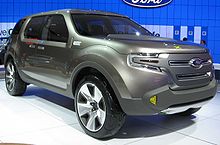







![Validate my RSS feed [Valid RSS]](valid-rss-rogers.png)















































































ไม่มีความคิดเห็น:
แสดงความคิดเห็น